Friday, May 19, 2006
Æ25, Cyzikus in Mysia, Gallienus, SNG France 878var...
(reverse legend)
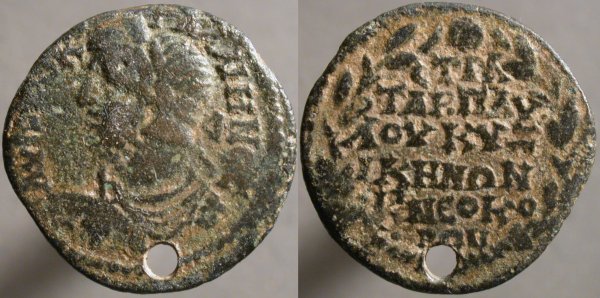
AVT [K Π ΛIK ΓA Λ]ΛIHNOC, Laureate draped bust left, holding globe (shield?) | CTRA / TAP·ΠAV / ΛOV KVZ / IKHNΩN / Γ·NEOKO / PΩN, Legend in six lines within wreath.
This design, naming the chief local magistrate, was used in many variations at Cyzikus. The office may have had a one-year term, and each new magistrate may have demanded a coin be issued for him.
This is for a magistrate, Paulus, who'se coins seem to have attracted no modern attention.
I try to usually avoid holed coins, but this had a generally legible reverse, a design I had no examples of, and the price was reasonable. That it turns out to add a crumb to historical knowledge is just cool.
(Waving at Paulus, not quite forgotten, 1,750-some years distant).

AVT [K Π ΛIK ΓA Λ]ΛIHNOC, Laureate draped bust left, holding globe (shield?) | CTRA / TAP·ΠAV / ΛOV KVZ / IKHNΩN / Γ·NEOKO / PΩN, Legend in six lines within wreath.
This design, naming the chief local magistrate, was used in many variations at Cyzikus. The office may have had a one-year term, and each new magistrate may have demanded a coin be issued for him.
This is for a magistrate, Paulus, who'se coins seem to have attracted no modern attention.
I try to usually avoid holed coins, but this had a generally legible reverse, a design I had no examples of, and the price was reasonable. That it turns out to add a crumb to historical knowledge is just cool.
(Waving at Paulus, not quite forgotten, 1,750-some years distant).
Thursday, May 18, 2006
Æ sesterius, Gallienus, Rome, Göbl 221
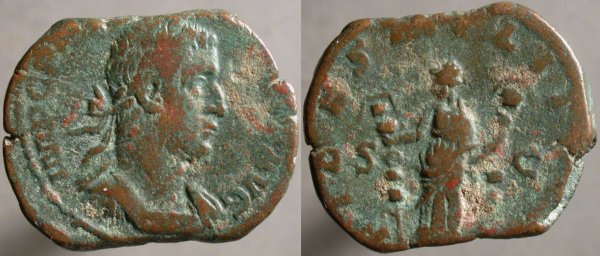
IMP C P[ LIC GALLIENVS P] F AVG, Laureate cuirassed bust right | FIDES MILITVM, Fides standing left, holding a standard to either side, S_C across fields.
Using the same reverse image as the coin I posted a week ago, this uses the second obverse legend, so this is from a slightly later issue. Stunningly ugly shape!
Some of the provincial cities minted large coins, so techniques for producing them weren't lost, but it seems that Rome didn't care enough to make the effort.
Wednesday, May 17, 2006
AR denarius, Q. Caecilius Metellus, Roman Republic. 130 BCE, Crawford 256/1
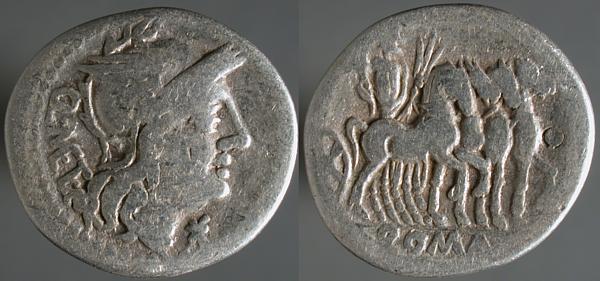
Helmeted head of Roma right, Q·METE downwards behind, XVI monogram beneath chin | Jove in quadriga right, holding branch in right hand, thunderbolt and reins in left, ROMA in exergue.
A very important family, the Caecilii Metelli. This moneyor could be Quintus Caecilius Metellus Balearicus, consul in 123 BCE and censor in 120 BCE, or Quintus Caecilius Metellus Numidicus, consul in 109 BCE and censor 102 BCE. I think Quintus Caecilius Metellus Nepos, consul in 98 BCE, is too young to have been a moneyor in 130 BCE, but I may be wrong. He also may have been a unmemorable relative.
Tuesday, May 16, 2006
Æ30, Mopsus in Cilicia, Valerian, SNG France 1999...
(same dies) , Sear GIC 4499
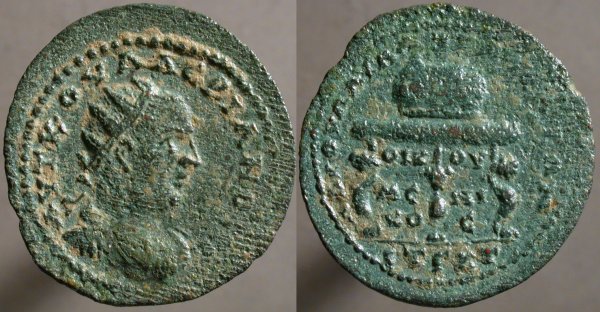
AVT K OVAΛEPIANOC CE, Radiate cuirassed bust right | AΔP OVAΛ ΓAΛ [MOΨEA]TΩN, Prize crown with palm, on table, OIK - OV / ME - NI / KO - C among legs, ET ΓKT in exergue.
The mark in the exergue is a date, 323, based on an era that began in 68 BCE, so this may commemorate (or announce?) games that honored the ascendance of a new emperor in 253 CE. With Philip I in 244, joined by his son Philip II in 247, then Trajan Decius in 249, Trebonianus Gallus in 251, Aemilian's brief reign in 253, and Valerian and Gallienus in 253, a city could go broke trying to honor each new emperor.

AVT K OVAΛEPIANOC CE, Radiate cuirassed bust right | AΔP OVAΛ ΓAΛ [MOΨEA]TΩN, Prize crown with palm, on table, OIK - OV / ME - NI / KO - C among legs, ET ΓKT in exergue.
The mark in the exergue is a date, 323, based on an era that began in 68 BCE, so this may commemorate (or announce?) games that honored the ascendance of a new emperor in 253 CE. With Philip I in 244, joined by his son Philip II in 247, then Trajan Decius in 249, Trebonianus Gallus in 251, Aemilian's brief reign in 253, and Valerian and Gallienus in 253, a city could go broke trying to honor each new emperor.
Monday, May 15, 2006
Hadrian comes to the Antipodes
At Silent Running.
Æ antoninianus, Salonina, ancient counterfeit of Göbl 555p
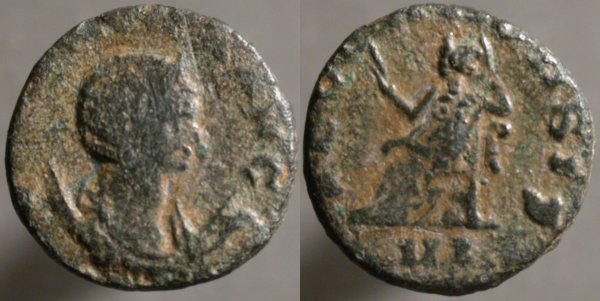
[SALONINA AV]G, Diademed draped bust right on crescent | SEC[VRIT OR]BIS, Securitas seated left, holding scepter in right hand, left hand to hair. VI in exergue.
The reverse is a pretty good copy of official coins, but those were are minted for Gallienus, and this obverse, of his wife, Salonina, is less convincing. Ancient counterfeits are interesting, but I'm not sure there's much to learn from them. If it were possible to classify them by which counterfeiter created them, and where, and determine how widely they travelled, we'd learn something about how widely coumterfeits were accepted, but I don't imagine that's going to happen.
Sunday, May 14, 2006
Numismatica
Via A Gift For Polydektes, Guide to the Principal Gold and Silver Coins of the Ancients and BMC Sicily are now available for reading at Google Books.
-->

